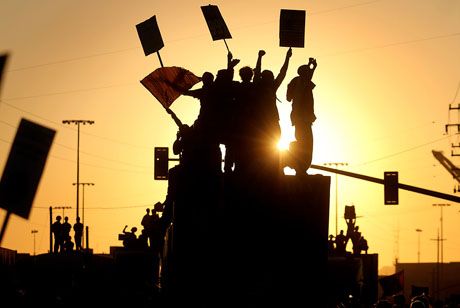Columns
You are here
The Comintern and the ‘black question’

October 5, 2012
The Communist International (Comintern) Fourth Congress, meeting in 1922, prefigured many discussions regarding international solidarity and activism that will be familiar to socialists today. One such discussion focused on anti-racist politics, in particular regarding African-American experiences in the United States.
In John Riddell’s recent translation of the Fourth Congress proceedings, Toward the United Front, the events surrounding the discussion of “the Black question” are presented, with helpful annotations for the contemporary reader.
The presentation by Otto Huiswoud (also known as Billings)—a delegate to the Comintern from the US—is particularly compelling. His comments were reflective of his lifelong commitment to socialism and black liberation. John Riddell’s biographical noteshelp to set the scene.
Generations
Huiswoud’s activism spanned the generations from the Comintern to the civil rights era. Born in Suriname in 1893, Huiswoud moved to New York in 1910. In 1919, he became one of the founding members of the American Communist Party. Before his death in 1961, he would serve the movement as editor of the US publication Negro Worker, help to lead the American Negro Labor Congress, and meet to discuss politics of the day with those such as VI Lenin, Aimé Césaire, Franz Fanon and Richard Wright.
At the time of the Fourth Congress, Huiswoud was encouraged by the potential of the Comintern to address issues of racism in connection with colonialism and imperialism. He reminded delegates of the historic break with the reformist Second International, recalling earlier statements that the “Second International is an International of white workers and the Communist International is an International of the workers of the world.”
But the bulk of Huiswoud’s comments were cautious, aware of the lack of knowledge among the majority of Comintern delegates. He emphasized that “he Black question is another part of the racial and colonial question, and it has until now not received any special attention.”
And he appealed to delegates to take seriously the Comintern’s formal commitment to carrying on socialist organizing among black workers internationally, “not merely as a New Year’s resolution but as work to be carried out in reality and in action.”
Race and class
Huiswoud’s report to the Fourth Congress stressed the necessity of avoiding economic reductionism in considering anti-racist organizing.
The relationship between race and class, a question that continues to animate Marxist theorizing today, demanded an understanding of history, and of divisions as well as unifying factors in the working class.
“As is generally known, the question of race, based as it is on prejudice arising from the class prejudices of specific groups in society, still plays an important role. It is true that in the United States, for example, the competition between Black and white workers is the main source of racial hatred. But we must not forget that the Blacks still bear the mark of bondage stemming from the time of slavery. For this reason we find that the particular antagonism of white workers against Black workers takes a special form.”
Huiswoud stressed the role of consciousness, emphasizing what he termed “the psychological aspects of the question.”
He condemned the legacy of overt racism in some of the leading US trade unions, which established as “a condition of membership that each white brother will recruit other white workers.” This had the effect of ensuring that “Blacks will always remain outside the union, simply because they are Black.” The consequences were dire, as black workers could be hired by anti-union employers to cross picket lines of white workers. As Huiswoud implored: “We can advance all the fine theoretical formulations that we have at hand, but yet in the daily struggle there are some harsh and stubborn facts.”
US South
One of the most significant parts of Huiswoud’s report addressed the conditions of the US South.
“The Blacks sense the approach of a crisis that will break out between whites and Blacks in the South. The seeds have been sown in the South and they must sprout up there in some form. It is likely that the crisis will take the form of race baiting on a vast scale.”
Huiswoud strived to paint a picture of the concrete realities of early twentieth century racism to his Comintern comrades, explaining that the South is “almost a separate country,” and compared it to Dante’s inferno. He continued: “The division is kept very sharp, and Blacks are robbed of their right to vote.…This is where you find lynching and racial uprisings. You see that in the South, the lynching of a Black is the occasion for enjoyment, as it is elsewhere to go to the cinema. When you grasp that the white population of the South is so imbued by this notion of white domination of the Blacks, you will also understand that we must take up this question.”
Otto Huiswoud anticipated both the racist violence and the revolts of black workers in years to follow, not least the civil rights movement decades later. He is just one of many nearly forgotten socialists, whose contributions are brought to life in Toward the United Front.
Section:
Topics:
- Log in to post comments










